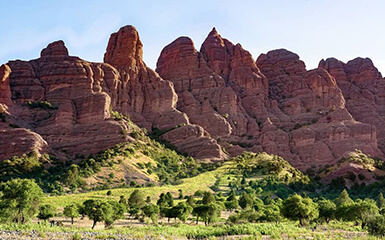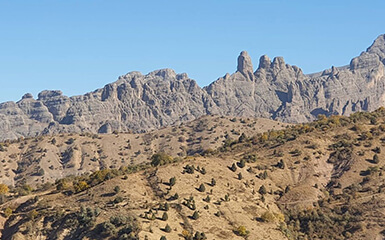Kok Gumbaz
Ajina Teppa
Ancient Panjakent
Anzob Tunnel
Beshkent Qala
Childukhtaron
Khazrati Shokh
Mug Teppa
Gharm Chashma
Hisor Historical
Haji Yaqub mosque
Hazrati-Bobo complex
Lake Iskanderkul
Kalai-Khumb
Karatag
Karon
Khishtin caravanserai
Khorog
Khulbuk
Lake Karakul
Abdullatif Sultan
Madrasai Kuhna
Abu Abdullah Rudaki
Khoja Mashhad
Khudoyor Valami
Makhmudi Azam
Mir Sayyid Ali Hamadani
Muhammed Bashoro
Sheikh Muslihiddin
Nurek Mountain Lake
Pamir
Sarazm
Sari-Khosor
Seven Lakes
Shirkent
Chiluchorchashma
Takht-i Sangin
Childukhtaron – forty girls

In the Khatlon region of Tajikistan, about 250 kilometres south of Dushanbe, there is a unique place famous for its natural complex of reddish rocks. The Childukhtaron tract (translated from Tajik “forty girls”) is so mesmerizing with its unusual beauty that it seems that there is nothing like it in the whole world. The Ferghana correspondent went there to see this miracle of nature with his own eyes.
This very beautiful place is popular with both tourists and Tajiks. More than 60 species of flora grow here, 22 of which are included in the "Red Data Books" of the countries of Central Asia. In particular, many types of medicinal plants can be found here. However, the most important thing is the view.
The Khovaling Valley, in which Childukhtaron is located, is located at an altitude of 1600 meters above sea level. From time immemorial, brave Tajik aborigines lived here, who did not allow nomadic conquerors to conquer or enslave them. According to a legend passed down from generation to generation, in the 13th century, the Mongol army crossed the local river and began to storm the local fortress. Local residents fiercely defended themselves. In the forty days that they withstood the siege, almost all the men died, except for forty young soldiers who were supposed to protect women, girls and children. They took their charges to the Sangdara (stone gorge) and Sangvor (rocky) mountains, and then returned to give the last battle to the enemies.
After the death of 40 young heroes, girls and women hiding in the mountains planted 40 plane trees in memory of them. Hence, another toponym arose - Chilchanor (Forty Chinar). Instead of the dead men, forty girls armed themselves and went to defend their native land from the enemy. The battle with the Mongols turned out to be unequal, and the girls had to retreat to the mountains. They knew that they could become victims of the rapist Mongols, and did not want to be captured. At the last moment, they turned to the Almighty to turn them into stones and thereby save them from shame and violence. The girls' prayer was heard and they became rocks.

